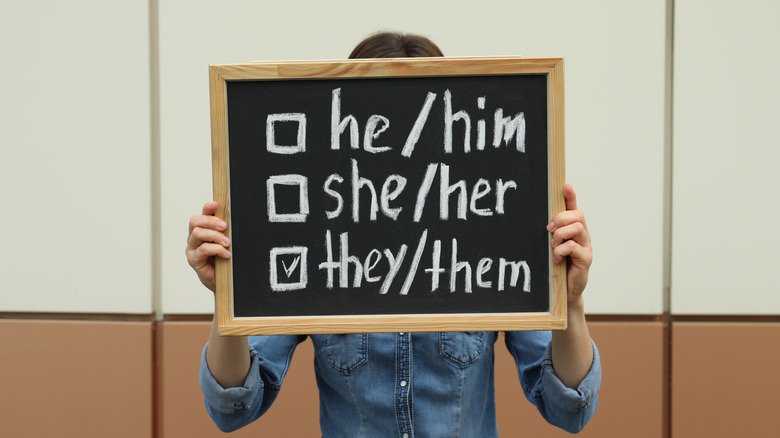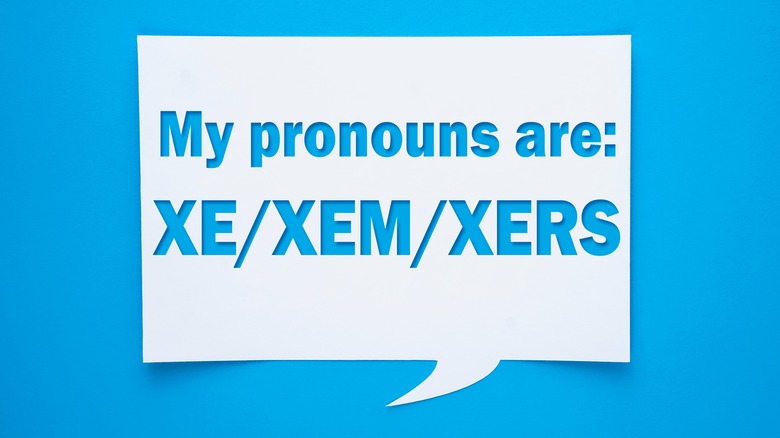Everything You Need To Know About Neopronouns
Human beings have been searching for better, more inclusive ways to discuss gender for centuries. While some have sought an easier, clearer way to refer to groups of people in writing or conversation, others have found a need for personal pronouns that more closely align with their unique identities.
Gender-neutral pronouns and neopronouns are a way for people primarily within the transgender, nonbinary, and queer communities to expand upon gender constructs and their traditionally assigned pronouns. Neopronouns in particular are being used as a way to separate entirely from gender (via The Atlantic). Words like "ze/hir," "e/er," and even "kitten/kittenself" are unique identifiers commonly used. On a broad scale, they are seen as niche terminology whose use is primarily limited to online spaces.
Although not everyone is a fan of unique personal pronouns, they are a tool for the individual to help them refer to themselves in a way that aligns with their personhood. This is important because, according to The Trevor Project, 25% of LGBTQ youth use a combination of gender-neutral and neopronouns. Although the words themselves may seem strange, silly, or made up to some, the importance of neopronouns cannot be overlooked. Here is everything you need to know about neopronouns, including what they are, how they are used, and their role in both language and gender identity.
Personal pronouns vs. gender-neutral pronouns
To understand what a neopronoun is, here's a little trip back to English Grammar 101. Pronouns are an integral and powerful part of speech. Grammatically, they are words that can replace both proper and common nouns in a sentence (via Grammarly). These small but mighty words do the same work as nouns but in a shorter, more concise way. When most people think of pronouns, they think of personal pronouns, although there are many others used in regular speech. Personal pronouns are words that refer to a particular person and include the standard "he/him," "she/her," and "they/them."
Personal pronouns have historically been used in correlation with a person's gender, meaning "he/him" referred to a man while "she/her" referred to a woman. However, not every person identifies as the gender they were assigned at birth. In this instance, "they/them/theirs" is often used as a gender-neutral pronoun.
Gender-neutral pronouns are currently a hotly debated cultural and societal topic. According to The Atlantic, gender-neutral pronouns have generally been used to describe groups of people or individuals when their gender wasn't known. It is only in recent years that gender-neutral pronouns have been used by people to describe themselves. Nowadays it is common for people to share their preferred pronouns in their social media bios, on their websites, on nametags, and in their email signatures as a way to help others address them appropriately.
What are neopronouns?
Gender-neutral or nonbinary pronouns like "they/them/theirs" have helped people who don't identify as male or female refer to themselves and correctly reflect their gender. However, there are plenty of individuals who do not identify with any gender at all, even in a neutral capacity. For these folks, there is a significant lack of representation in the English language (via the Neopronouns Guide).
Enter neopronouns. Neopronouns, or neos, are an alternative to traditional third-person personal pronouns like he, she, or they. They exist as a category of neologistic English. According to Language Humanities, neologisms like neopronouns are brand-new words that have gained popularity in a particular language but are not commonly used. Their origin varies; sometimes they come from social media influence or scientific language, while other times they appear naturally due to cultural and societal happenings.
Neopronouns are classified as gender-neutral parts of speech that can be used by a man, woman, or neither. However, neopronouns are intentionally designed to exist outside the binary and neutral spaces. Mostly, neopronouns allow people the ability to embrace both the masculine and feminine parts of themselves if they want. They are also a way to empower people who consider themselves to be outside the traditional labeling system. Neopronouns are particularly popular in online queer spaces and amongst the transgender community.
Are neopronouns a new thing?
Contrary to popular belief, neopronouns aren't new. This surprises many, especially considering the word "neo" means new in Latin. Despite their space-age-like look and sound, many neopronouns are actually sets of more than 200 different gender-neutral pronouns that have been developed and introduced over several hundred years.
According to the Human Rights Campaign, the creation of new pronouns dates back to the 12th century. At the time, the pronouns "he" and "heo" were Old English gender pronouns in use. Over time, these two pronouns became confusingly interchangeable which led to the creation of the feminine pronoun "she." Several centuries later, the pronoun "ou" and the gender-neutral pronoun "a" entered the English language.
"Thon," a combination of "that" and "one," was a recognized gender-neutral pronoun from 1934 to 1961 in Merriam-Webster's Unabridged Dictionary. In their history of neopronouns, Mermaids UK notes that modern census data concludes "thon" is still used in modern language by people who prefer the term to other pronouns.
In 1852, gender-neutral pronouns ne, nis, nir, and hiser were proposed as wording for "the common gender" in the New-York Commercial Advertiser (via The Web of Language). A short 20 years later, The Atlantic published an article by Napolean Bonapart Brown who argued the need for a new pronoun was desperate and urgent. In his opinion, it was baffling that a personal pronoun that represented a singular number and the common gender had not naturally come about as a part of the language.
Who can use neopronouns?
The UNC Greensboro Division of Student Affairs writes that neopronouns can be used by anyone, although they are increasingly used by transgender, non-binary, or gender-nonconforming people. More specifically, many people who use neopronouns categorize themselves as genderqueer, genderfluid, fluctuating gender, or unfixed gender identity (via LGBTQ Nation). The reason these groups often use neopronouns in lieu of the singular "they/them" is that they do not feel those are the right words to describe their personhood. Even the use of "they/them" can force people into adhering to the gender binary many are desperate to get away from.
People who identify as cisgender and/or heterosexual are also free to use neopronouns if they wish. The very nature of neopronouns allows for inclusivity and broad use. For example, if you identify as a woman but want to utilize a gender-neutral pronoun that pushes beyond that identity, neopronouns are a way to do that. However, it is vital that people outside of the LGBTQ community use them with respect.
Are neopronouns grammatically correct parts of speech?
People who oppose the use of neopronouns often argue that they are made-up words without context or meaning to anyone but the individual. Stalwarts of the English language consistently proclaim the indispensable need for gendered pronouns, ignoring or rejecting the continued attempts to broaden the language and increase its inclusivity (via The Web of Language). Some people also struggle with using pronouns like "they/them" or "xe/xim" because they are often used to indicate a plurality. While it is true that neopronouns can be or look like made-up words with unique contextual meanings, it doesn't exclude them from being grammatically correct parts of speech.
According to Rolling Stone, the Oxford English Dictionary (OED) has not yet made an entry for the word "neopronoun." This isn't because the word or the terms it embodies aren't grammatically correct. Rather, the OED waits to include new words in the dictionary until that word becomes broadly used and understood.
New words and phrases join the common lexicon all the time. For example, prior to the 21st century, words like "emoji," "sexting," "foodie," "selfie," "clickbait," and "blog" didn't exist. While these are mainly examples of technologically-driven words, the same principles that make them grammatically correct parts of speech after their adoption hold true for neopronouns. And while it is difficult for English speakers to understand the invention and practicality of neos and gender-neutral pronouns, there are many languages where pronouns don't have any gender such as Swahili or Estonian.
The pushback against neopronouns
The aspect of grammatical incorrectness is a huge argument for many who oppose the existence and continued use of neopronouns, but it isn't the only one. Many heterosexual, cisgender, and older people also struggle to accept these identifiers, citing their fluidity makes them too much of a hassle to keep track of. They also argue that because a person's neopronouns can change from day to day, or even multiple times a day, it is impossible to know the right words to refer to them at any given moment.
However, according to Rolling Stone, the pushback against neopronouns isn't limited to cisgender people. While neopronouns are used primarily by the queer and trans communities, there are people within those communities that dislike their use also. In these instances, they believe that the sheer number of available neopronouns is getting way out of hand. Some members of the community have argued that the constant changing of personal pronouns is an attention-seeking habit rather than an expression of fluidity, and makes the community look like a joke (via The Irish Times). It can also be difficult for people who transition to one gender or the other to see their hard-fought journey be reduced or erased by people who aim to create a genderless world.
Examples of common neopronouns
There is an endless number of neopronouns in use. The most common are "e/em/eir," ze/hir/hirs," "xe/xir/xirs," "per/per/pers," and "ze/zir/zirs." Each set includes a subjective, objective, and possessive form. Some neopronouns come from Sci-Fi books, slang, and pop culture, while others are made-up words without themes that symbolize human beings without gender.
"E/em/eir/eirs/emself" is a popular choice that mathematician Michael Spivak created in the 1990s. Spivak wrote a five-volume book called "A Comprehensive Introduction to Differential Geometry." In this book, and in his online community LambdaMOO, Spivak purposefully utilized pronouns that did not differentiate between men and women. To this day, these pronouns are often referred to as Spivak pronouns (via Fact-Index).
In an effort to truly capture their unique identity, other users choose neopronouns that embody a feeling or vibe they want to express. For example, in the neopronoun subreddit, users in search of the right neopronoun will reach out to fellow Redditors for help (via Reddit). They may post an emotion, animal, or even an aesthetic they associate with and take suggestions from others in the community for neopronouns that fit. Examples that fall under this umbrella vary extensively, from houseplant-related neopronouns like "fern/ferns/fernself" to dreamy pronouns like "del/delph/delphself" (via Neopronoun List). Once chosen, these pronouns are not fixed. Their fluid nature allows them to be tried on and put down at the user's discretion.
How to use neopronouns
Understanding what a neopronoun is and its importance to the user can feel drastically different from knowing how to use them correctly. According to LGBTQ and All, it's daunting for newbies to grasp simply because the culture and language they exist within don't currently accommodate them.
Americans as a group are pretty divided on both awareness and comfortability of using gender-neutral and neopronouns. A 2019 report by the Pew Research Center found that age and political affiliation play a huge role in awareness of the use of gender-neutral pronouns. For example, 61% of adults ages 18-29 would be very or somewhat comfortable using gender-neutral pronouns to refer to someone else if asked. On the other hand, 51% of adults 65 and older feel uncomfortable using them. The same survey found that 66% of Democrats have a level of comfortability with referring to others by gender-neutral pronouns compared with 34% of Republicans.
Despite these barriers, it is important to use neopronouns correctly when the situation arises. First and foremost, be respectful. Never assume someone's gender or pronouns and listen carefully when someone tells you what their pronouns are. If you aren't sure how to spell or pronounce them, ask. If someone doesn't offer their pronouns automatically upon meeting, you can ask "How should I refer to you?" to help clarify things.
Why pronouns matter
If you've never had to think about your personal pronouns, it can be hard to understand what all the fuss is about. How much can a handful of little words matter? The answer is: a whole lot. Per the UCSF LGBT Resource Center, we automatically use pronouns every day when communicating with others, but you can't tell a person's pronoun preferences just by looking at them. Traditional pronouns and their gender implications can lead to incorrect assumptions about who a person is. Over time, this constant mislabeling causes significant stress and lasting harm to people in the LGTBQ community in the form of invalidation, disrespect, and alienation.
This is particularly noticeable for young LGBTQ and gender-expansive youth. These individuals encounter a significant number of dangerous obstacles that make it harder to navigate their everyday lives. Less than 25% of transgender and gender-expansive youth feel comfortable being themselves in their homes or at school, while 51% never use bathrooms that align with their gender identity (via Human Rights Campaign). According to The Trevor Project, transgender and nonbinary youth who have their declared pronouns respected by their friends and family attempt suicide at half the rate of those whose pronouns aren't respected.
Using a person's correct personal pronouns is both respectful and inclusive (via Pronouns.org). It shows support for members of the community, helps people feel more comfortable about themselves and the space they're in, and sets an example for others on how to treat people.
What if you address someone with the wrong neopronouns?
As important as neopronouns are to the people who use them, they haven't exactly gone mainstream. They are also a bit more complicated than traditional personal pronouns or "they/them." With this in mind, it is possible that you will make a mistake and accidentally use the wrong pronouns when referring to someone else. If this happens, don't panic. Everyone makes mistakes. Give yourself a little grace, apologize, use the correct neopronouns, and work hard to do better next time (via LGBT Life Center).
Dwelling on the mistake or issuing a drawn-out apology isn't necessary. According to the University of Wisconsin LGTBQ+ Resource Center, it may feel appropriate to go on about how bad you feel about misgendering someone. Doing this will likely just embarrass the person you're talking to while simultaneously making them feel as if they should comfort you for the mistake.
If you know the person in question switches up their neopronouns regularly, or if they use more than one set of pronouns, it's okay to ask what words you should use. Asking shows you care about their identity and respect them as a human being. Above all, make sure to listen when others share their preferred personal pronouns and remember how meaningful and impactful these identifiers are to the people who use them.










